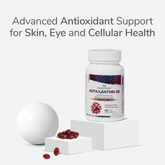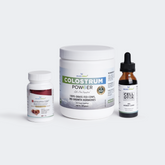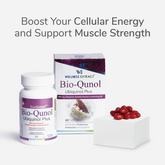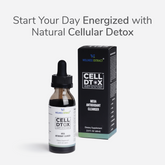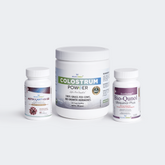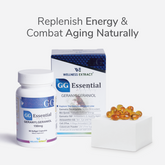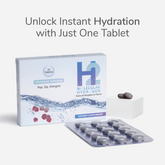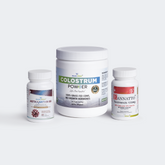From A to K: A Complete Guide to Vitamin-Rich Foods
Estimated Reading Time: 11 minutes
|Your body needs 13 essential vitamins for effective performance. The best part? Nature has packed every essential vitamin into delicious, everyday foods - all you need to ensure is to get the most out of them.
More than one-third of Americans take one or more vitamin supplements to fill the nutritional gap. Vitamins play a vital role in ensuring overall well-being, from vitamin A for sharp vision to vitamin K for strong bones. We all take supplements at some point in life, whether it’s to boost metabolism or build immunity against common illnesses. However, lab-prepared vitamins from bottles can't simply replace the power of biologically active compounds found in our everyday diet.
However, the question is: Which foods serve as the best natural vitamin sources and are readily available? Here is a detailed article highlighting the best food sources of vitamins A, B, C, D, E, and K and their importance in the human body.
First, What Are Vitamins? Why Are They Essential?
Vitamins are organic micronutrients found in plants and animals. They are vital for regular functioning and body metabolism. Considered essential because either our bodies can't produce them, or produce them in sufficient quantities, and we must obtain them from food.
Further, vitamins fall into two categories:
● Water Soluble Vitamins:
Water soluble vitamins include B-complex vitamins and C. They can readily dissolve in water, and the body excretes them at excessive levels. Simply put, our bodies can't store them in meaningful amounts and we need regular replacements regularly, or in some cases on a daily basis.
● Fat Soluble Vitamins
Fat-soluble vitamins comprise vitamins A, D, E, and K. These vitamins are stored in the liver and fatty tissues and eliminated quite slowly compared to their water-soluble counterparts.
Read More: Fat Soluble Vitamins and Importance
If vitamins are celebrity nutrients, where can you find them? Here is the list of common foods packed with vitamins and their superpowers.
Food Sources of Vitamin A, B, C, D, E, and K
The complete list of vitamins A, B, C, D, E, and K is given below, along with their importance and recommended dietary allowance (RDA).
1. Vitamin A
Whether it's vision, reproductive health, or immune development, vitamin A is a savior. Also called retinol, vitamin A helps the eyes to adjust to light stimulation.
According to WHO, about 500K children become blind annually due to severe vitamin A deficiency. What is worse? Half of them die within 12 months of losing their sight. Vitamin A also helps to maintain moisture around the mouth, nose, and throat, maintaining their functionality.
Recommended Dietary Allowance (RDA)
· 900 mcg/ day for adult males
· 700 mcg/day for adult females.
Food Sources of Vitamin A
Vitamin A is generally available in animals in retinol, retinal, and retinoic acid forms. It is also accessible in form of beta carotene, which is found in dark green and orange fruits and vegetables (beta carotene is orange in colour but the orange colour can't be seen in foods like spinach, kale, broccoli, rapini etc because its masked by the green colour of chlorophyll) The body later converts the absorbed beta-carotene into vitamin A in the intestine. Here is the list of food sources of vitamin A:
|
Food Source |
Key Characteristics |
Health Benefits |
|
Carrots, green veggies as kale or spinach. |
Rich source of beta-carotene, precursor of vitamin A |
Eye vision and skin health, immunity, cell-growth and reproduction |
|
Cod Liver Oil |
Exceptionally high in retinol and omega-3s |
Vision and heart health |
|
Liver (Beef/Lamb) |
One of the richest sources of vitamin A |
Cell repair and vitality |
|
Mangoes/Sweet Potatoes |
Vitamin A rich and delicious |
Healthy vision and immune support |
|
Egg Yolks |
Contains retinol and lutein |
Support brain and eye function |
2. Vitamin B
Out of the 13 essential vitamins, eight directly come from the B-group. They are water-soluble vitamins that support energy production and cell function. You might be surprised to find out that athletes and highly active individuals require 30-50% more B vitamins to sustain energy levels.
Additionally, vitamin B also contributes to brain health and nerve function, improving cognitive function, signal transmission, and mood regulation.
Also Read: Best Daily Vitamins for Females - Essential Guide
Recommended Dietary Allowance (RDA)
The recommended dietary allowance of a given B vitamin further depends on its types and subtypes. Here is the recommendation about popular vitamin B types:
|
Vitamin B Types |
RDA |
|
B6 (Pyridoxine) |
1.3 mg/day |
|
B7 (Biotin) |
30 mcg/day |
|
B9 (Folate) |
400 mcg/day |
|
B12 (Cobalamin) |
2.4 mcg/day |
Food Sources of B Vitamins
B vitamins are uniformly distributed in different food sources, including:
|
Food Source |
Key Characteristics |
Health Benefits |
|
Whole Grains |
Rich in vitamin B1 and B3 |
Energy metabolism and brain function |
|
Legumes |
High in B1, B6, and B9 (folate) vitamins |
Digestion, nerve function, fetal development |
|
Fortified Cereals |
Enriched with B1, B2, B3, B6, and B12 |
Energy levels and cognitive health |
|
Nuts & Seeds |
Contain B1, B2, B6, and B7 (biotin) vitamins |
Heart health and energy production |
|
Bananas |
Good source of vitamin B6 |
Regulate mood and nervous system |
|
Lean Meats |
Potent source of vitamin B3, B6, and B12 |
Energy and nerve function |
|
Fish (Salmon, Tuna, Trout, Sardines) |
Packed with vitamin B3, B6, and B12 |
Cardiovascular and neurological health |
|
Leafy Greens |
Including spinach, kale, romaine, and lettuce packed with vitamin B9 (folate) |
Support DNA synthesis and fetal development |
3. Vitamin C
Vitamin C, popularly known as ascorbic acid, contributes to immune health and helps synthesize collagen, which is responsible for radiant and supple skin. Additionally, vitamin C also stimulates L-carnitine production, which is responsible for energy metabolism.
Remember how vitamin C supplements became a staple for immunity during the pandemic? It is because vitamin C boosts the activity of T cells and phagocytes, stimulating the body's disease-fighting mechanism.
Recommended Dietary Allowance (RDA)
· 90 mg/ day for adult males
· 75 mg/day for adult females.
· Additionally, the requirement increases during pregnancy and lactation.
Food Sources of Vitamin C
Citrus fruits, bell peppers, and cruciferous vegetables are the ultimate source of vitamin C. Here are the other popular food sources:
|
Food Source |
Key Characteristics |
Health Benefits |
|
Citrus Fruits |
Oranges, lemons, limes, and grapefruits high in vitamin C |
Immunity support and collagen production |
|
Strawberries |
Packed with potent antioxidants |
Skin health and heart function |
|
Cruciferous Vegetables |
Such as broccoli, brussels sprouts, cabbage, and cauliflower rich in vitamin C |
|
|
Berries |
Blueberries, raspberries, blackberries loaded with vitamin C and other antioxidant |
Brain health and antioxidative |
|
Acerola Cherries and Guava |
One of the richest natural sources of vitamin C |
Collagen production, wound healing, and antioxidative |
4. Vitamin D
Vitamin D, often dubbed the sunshine vitamin, works by increasing calcium and phosphorous absorption, contributing to bone health. Without vitamin D, less than 10-15% of dietary calcium is absorbed by the body.
Low vitamin D levels may result in osteoporosis risks, autoimmune disorders, high blood pressure, and cardiovascular threats. Vitamin D plays a vital role in ensuring strong bones and healthy teeth, especially among children.
Recommended Dietary Allowance (RDA)
· 600 IU (15 mcg) for adults (ages 19-70)
· 800 IU (20 mcg) for seniors living above 70 years
Food Sources of Vitamin D
Talking about the source of vitamin D, sunlight instantly comes to mind. However, sunlight is not a food source of vitamin D, but it is essential for synthesis.
Fun Fact: Vitamin D2 (ergocalciferol) is plant-derived, while D3 (cholecalciferol) comes from animal sources or is synthesized in the skin via sunlight. Studies show that D3 is more efficiently absorbed and has a longer duration of action in maintaining serum vitamin D levels.
Here are the food sources of vitamin D:
|
Food Source |
Key Characteristics |
Health Benefits |
|
Fatty Fish |
Such as Salmon, Mackerel, Tuna, and Sardines are the best natural sources of vitamin D3 |
Bone health and brain function |
|
Cod Liver Oil |
Exceptionally high in vitamin D3 |
Immune health and anti-inflammation |
|
Tofu (Fortified) |
A plant-based source of vitamin D2 |
Bone health and muscle function |
|
Fortified Cereals and Dairy Products |
Common vitamin D3 source for dairy dietary requirements, especially among vegans |
Bone strength and calcium absorption |
|
Mushrooms |
Sun-exposed mushroom varieties like Maitake, Shiitake, and Portobello are rare plant sources of vitamin D2 |
Immune function and brain health |
Also Read: Vitamin D Deficiency Symptoms
5. Vitamin E
Vitamin E, a powerful antioxidant, exists in two forms: tocopherols and tocotrienols, which further include four isomers each. Recent studies prove that tocotrienols are the most potent form of vitamin E and possess potential health benefits, including cardiovascular, neurological, and anticancer properties.
Vitamin E tocotrienols, with their flexible side chain, can penetrate deeper into the lipid membranes, neutralizing free radicals and reactive oxygen species. Despite the potent antioxidative properties, 90% of Americans & Canadians do not meet the daily Vitamin E requirements.
Also Read: 11 Reasons Why Tocotrienols Are Vitamin' E'ssential
Recommended Dietary Allowance (RDA)
For adults aged 14 and above, the Recommended Dietary Allowance (RDA) for vitamin E tocopherols is 15 mg per day, while for tocotrienols, as per studies the intake ranges from 200 to 400 mg per day.
Food Sources of Vitamin E
Here are the key food sources rich in vitamin E and its two primary forms:
|
Food Source |
Key Characteristics |
Health Benefits |
|
Nuts |
Nuts like almonds, hazelnuts, pine nuts, and peanuts contain tocopherols |
Skin health and protects against oxidative stress |
|
Annatto Seeds |
Derived from the Bixa Orellana Plant, a rich natural source of tocotrienols |
Anti-inflammatory and neuroprotective benefits |
|
Green Leafy Vegetables |
As spinach, kale, Swiss chard, and broccoli contain vitamin E and other antioxidants |
Antioxidative properties and vision support |
|
Palm Oil & Rice Bran Oil |
Contains both tocopherols and tocotrienols |
Cardiovascular and nervous support |
|
Seeds |
As sunflower, pumpkin, and sesame seeds contain high amounts of vitamin E tocopherols |
Immune function and skin health |
|
Shellfish |
Shellfishes like shrimps, lobsters, and oysters are rich sources of tocopherols |
Skin and immune function |
|
Fruits |
Like kiwi, mango, blackberries, tomatoes, and papaya are naturally rich in vitamin E |
Skin glow and immune support |
Also Read: Understanding Vitamin E Deficiency Symptoms
6. Vitamin K
Vitamin K is a fat-soluble vitamin, crucial for blood clotting and cellular protection. Additionally, it supports heart health, bone strength, and brain function. Vitamin K is available in two primary forms:
● Vitamin K1, also called Phylloquinone, is an important vitamin for blood clotting.
● Vitamin K2, known as Menaquinone, is responsible for calcium excretion from vessels to bones. It prevents calcium buildup or accumulation in the blood vessels.
Recommended Dietary Allowance (RDA) for Vitamin K1
· 120 mcg/ day for adult males
· 90 mcg/day for adult females.
Food Sources of Vitamin K
Given below is the list of food sources rich in vitamin K, along with their health benefits:
|
Food Source |
Key Characteristics |
Health Benefits |
|
Leafy Green Vegetables |
Kale, broccoli, collard greens, spinach, and Swiss chard are high in Phylloquinone |
Blood clotting and bone health |
|
Legumes |
Legumes like soybeans and lentils are some plant-based food sources of vitamin K1 |
Calcium regulation and cellular support |
|
Cruciferous Vegetables |
Green cruciferous vegetables are rich in vitamin K1 |
Calcium regulation and cardiovascular support |
|
Fermented Foods |
Including natto, sauerkraut, kimchi, and miso richest source of vitamin K2 |
Calcium regulation |
|
Fruits |
Some fruits, like blueberries, avocados, grapes, and figs, provide small amounts of vitamin K1 |
Heart and skin health |
Isn't that amazing? Beyond vitamin health supplements, countless natural vitamin-rich foods can unlock exciting health benefits for you.
Quick Recap
Vitamins are undoubtedly important micronutrients that contribute to overall health, from vision to the immune system. While balanced diets filled with fruits, vegetables, and dairy products can offer you the most of your vitamin requirements, it is best to know particular food sources for an informed decision.
From leafy greens to dairy products, nuts, and seeds to fermented delights and fishes, nature offers endless food sources to get your daily dose of vitamins. The above-mentioned food sources of vitamins A, B, C, D, E, and K in your diet can keep you healthy and strong. Lastly, remember—your health starts on your plate! Eat healthy and stay nourished.
Disclaimer: These statements have not been evaluated by the FDA. The information contained within this page is for educational purposes only. It is not intended to replace the advice or attention of health care professionals.
Frequently Asked Questions (FAQs)
Q1. What are the best food sources of vitamin A?
Some of the top food sources of vitamin A include carrots, spinach, sweet potatoes, kale, and lamb liver. These foods are rich in beta-carotene, a carotenoid that the body converts into vitamin A.
Q2. What foods are high in vitamin B?
Fish, poultry, meat, eggs, dairy products, legumes, whole grains, and leafy green vegetables are abundant in vitamin B. These foods provide different types of B vitamins, such as B1 (thiamine), B2 (riboflavin), B3 (niacin), B6, B9 (folate), and B12.
Q3. Which foods are rich in vitamin C?
Citrus fruits (oranges, lemons, and grapefruits), strawberries, kiwis, bell peppers, broccoli, and tomatoes are some of the best food sources of vitamin C.
Q4. What are the primary food sources of vitamin D?
Fatty fish like salmon, egg yolks, mushrooms, beef liver, fortified dairy products, and cereals are good dietary sources of both vitamin D2 and vitamin D3.
Q5. Which foods are high in vitamin E?
Foods rich in vitamin E include spinach, broccoli, seeds and nuts, and vegetable oils (such as sunflower, safflower, and wheat germ oil).
Q6. What are the top food sources of vitamin K?
You can get abundant vitamin K from green leafy vegetables. Other vitamin K sources include Brussels sprouts, cabbage, and fermented foods like sauerkraut.
Q7. How can I incorporate these vitamins into my diet?
You can add sufficient vitamins to your diet by consuming a balanced diet full of lean proteins, fruits, vegetables, nuts, seeds, legumes, whole grains, and dairy products. In another case, you may consider a healthcare professional for a customized diet plan or vitamin supplements.
Q8. Should I consult a healthcare professional for vitamins or nutritional advice?
It is best to consult with a medical professional or registered dietitian for personalized nutritional advice on sources of vitamins A, B, C, D, E, and K. They can help create a balanced diet plan tailored to specific dietary needs and address any concerns or health conditions you may have.


















